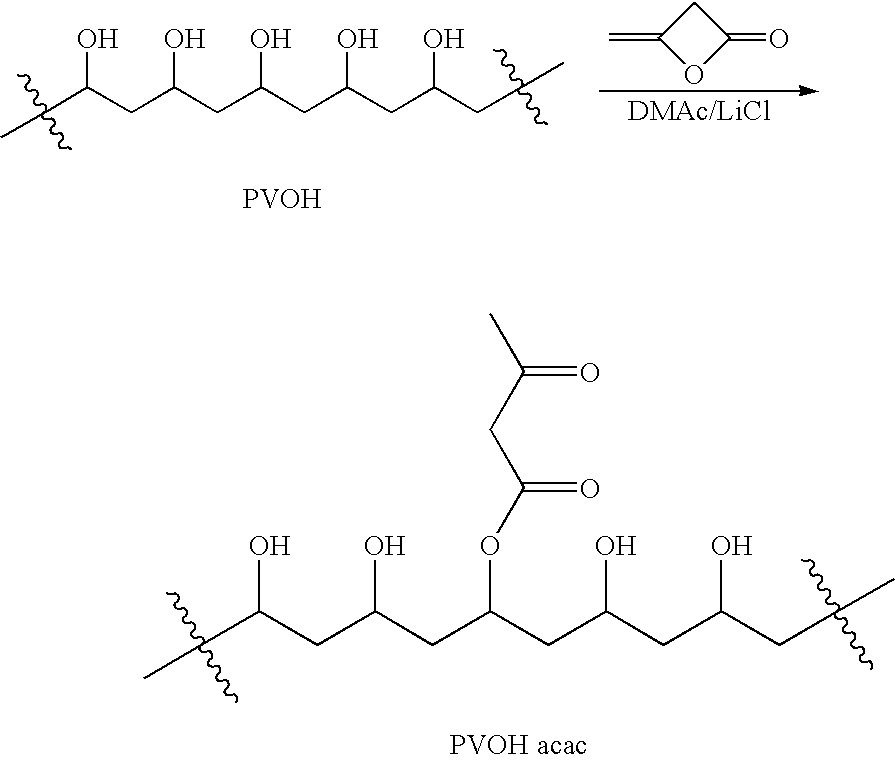Aldol-crosslinked polymeric hydrogel adhesives
a polymer and hydrogel adhesive technology, applied in the field of adhesives, can solve the problems of limited internal application use of fibrin-based adhesives, slow curing of fibrin-based adhesives, and general inapplicability of conventional tissue adhesives to a wide range of adhesive applications
- Summary
- Abstract
- Description
- Claims
- Application Information
AI Technical Summary
Benefits of technology
Problems solved by technology
Method used
Image
Examples
examples
[0103]The present invention is further defined in the following Examples. It should be understood that these Examples, while indicating preferred embodiments of the invention, are given by way of illustration only. From the above discussion and these Examples, one skilled in the art can ascertain the essential characteristics of this invention, and without departing from the spirit and scope thereof, can make various changes and modifications of the invention to adapt it to various uses and conditions.
[0104]The meaning of abbreviations used is as follows: “min” means minute(s), “h” means hour(s), “sec” means second(s), “d” means day(s), “mL” means milliliter(s), “L” means liter(s),“μL” means microliter(s), “cm” means centimeter(s), “mm” means millimeter(s), “μm” means micrometer(s), “mol” means mole(s), “mmol” means millimole(s), “g” means gram(s), “mg” means milligram(s), “meq” means milliequivalent(s), “PVOH” means polyvinyl alcohol, “acac” means acetoacetate, “PVOH acac” means po...
examples 1 and 2
Preparation of Dextran Aldehyde-Polyvinyl Alcohol Acetoacetate Hydrogels
[0116]The purpose of these Examples was to prepare and characterize dextran aldehyde-polyvinyl alcohol acetoacetate hydrogels. The hydrogels were prepared by reacting dextran aldehyde and polyvinyl alcohol acetoacetate in the presence of sodium carbonate as a base catalyst.
Preparation of Hydrogels:
[0117]The following solutions were prepared and used to make hydrogels:
[0118]
1A 25 wt % dextran aldehyde (Mw = 10 kDa; 48% conversion; eqwt = 160);1B19 wt % PVOH acac (Mw = 31-50 kDa; eq wt = 440) + 1 wt %sodium carbonate;1C19 wt % PVOH acac (Mw = 31-50 kDa; eq wt = 600) + 1 wt %sodium carbonate.
[0119]Hydrogel disks were prepared by mixing the dextran aldehyde solution, contained in a 2 mL syringe, with the PVOH acac solutions, contained in 1 mL syringes, as shown in Table 1, using a syringe Y-mixer with a 13-stage static mixing tip (ConProtec, Inc., Salem, N.H.). The syringe-mixed liquid was quickly extruded from the ...
examples 3-11
Preparation of Dextran Aldehyde-Polyvinyl Alcohol Acetoacetate Hydrogels with Different Swelling Properties
[0133]The purpose of these Examples was to prepare dextran aldehyde-polyvinyl alcohol acetoacetate hydrogels having different swelling properties by using dextran aldehyde having different oxidation conversions and PVOH acac with different equivalent weights.
Preparation of Hydrogels:
[0134]The following solutions were prepared and used to make hydrogels:
[0135]
2A25 wt % dextran aldehyde (Mw = 10 kDa; 48% conv; eq wt = 160)2B25 wt % dextran aldehyde (Mw = 10 kDa; 35% conv; eq wt = 210)2C25 wt % dextran aldehyde (Mw = 10 kDa; 23% conv; eq wt = 330)2D19 wt % PVOH acac (Mw = 31-50 kDa; eq wt = 600) + 0.25 wt %Na2CO32E19 wt % PVOH acac (Mw = 31-50 kDa; eq wt = 740) + 0.25 wt %Na2CO32F19 wt % PVOH acac (Mw = 31-50 kDa; eq wt = 925) + 0.25 wt %Na2CO3.
[0136]Hydrogel disks were prepared as follows. The Luer end was cut off a disposable 10-mL plastic syringe. The plunger was withdrawn abou...
PUM
| Property | Measurement | Unit |
|---|---|---|
| equivalent weight | aaaaa | aaaaa |
| molecular weight | aaaaa | aaaaa |
| equivalent weight | aaaaa | aaaaa |
Abstract
Description
Claims
Application Information
 Login to View More
Login to View More - R&D Engineer
- R&D Manager
- IP Professional
- Industry Leading Data Capabilities
- Powerful AI technology
- Patent DNA Extraction
Browse by: Latest US Patents, China's latest patents, Technical Efficacy Thesaurus, Application Domain, Technology Topic, Popular Technical Reports.
© 2024 PatSnap. All rights reserved.Legal|Privacy policy|Modern Slavery Act Transparency Statement|Sitemap|About US| Contact US: help@patsnap.com










